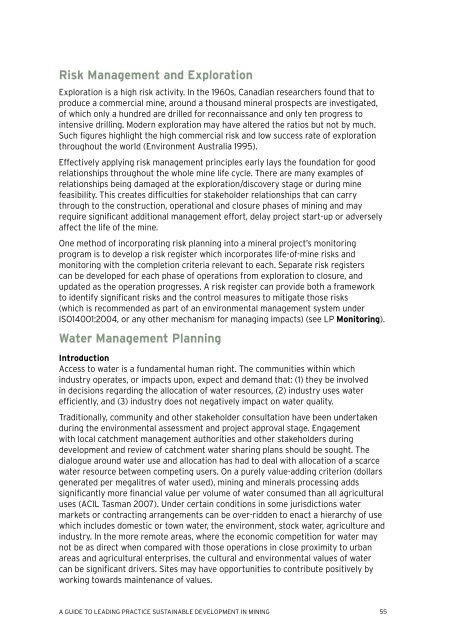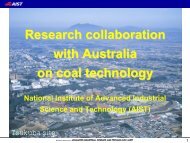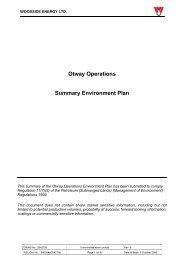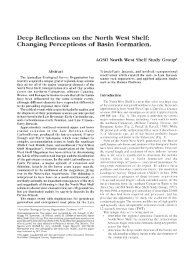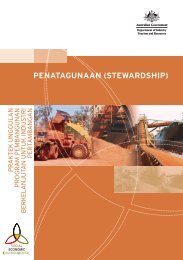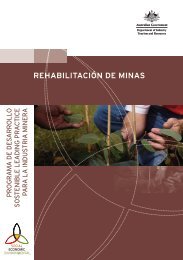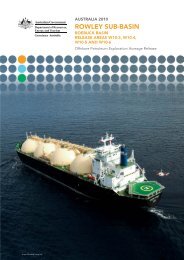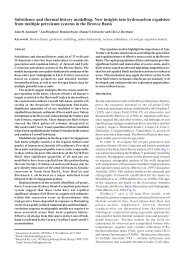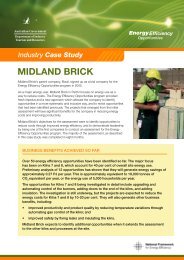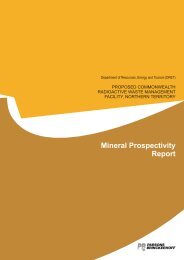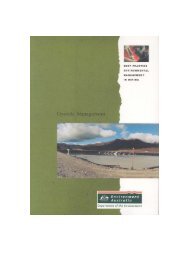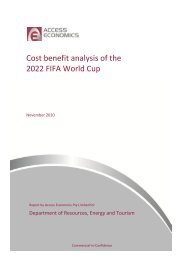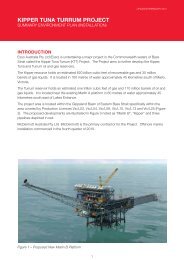A guide to leading practice sustainable development in mining
A guide to leading practice sustainable development in mining
A guide to leading practice sustainable development in mining
You also want an ePaper? Increase the reach of your titles
YUMPU automatically turns print PDFs into web optimized ePapers that Google loves.
Risk Management and Exploration<br />
Exploration is a high risk activity. In the 1960s, Canadian researchers found that <strong>to</strong><br />
produce a commercial m<strong>in</strong>e, around a thousand m<strong>in</strong>eral prospects are <strong>in</strong>vestigated,<br />
of which only a hundred are drilled for reconnaissance and only ten progress <strong>to</strong><br />
<strong>in</strong>tensive drill<strong>in</strong>g. Modern exploration may have altered the ratios but not by much.<br />
Such figures highlight the high commercial risk and low success rate of exploration<br />
throughout the world (Environment Australia 1995).<br />
Effectively apply<strong>in</strong>g risk management pr<strong>in</strong>ciples early lays the foundation for good<br />
relationships throughout the whole m<strong>in</strong>e life cycle. There are many examples of<br />
relationships be<strong>in</strong>g damaged at the exploration/discovery stage or dur<strong>in</strong>g m<strong>in</strong>e<br />
feasibility. This creates difficulties for stakeholder relationships that can carry<br />
through <strong>to</strong> the construction, operational and closure phases of m<strong>in</strong><strong>in</strong>g and may<br />
require significant additional management effort, delay project start-up or adversely<br />
affect the life of the m<strong>in</strong>e.<br />
One method of <strong>in</strong>corporat<strong>in</strong>g risk plann<strong>in</strong>g <strong>in</strong><strong>to</strong> a m<strong>in</strong>eral project’s moni<strong>to</strong>r<strong>in</strong>g<br />
program is <strong>to</strong> develop a risk register which <strong>in</strong>corporates life-of-m<strong>in</strong>e risks and<br />
moni<strong>to</strong>r<strong>in</strong>g with the completion criteria relevant <strong>to</strong> each. Separate risk registers<br />
can be developed for each phase of operations from exploration <strong>to</strong> closure, and<br />
updated as the operation progresses. A risk register can provide both a framework<br />
<strong>to</strong> identify significant risks and the control measures <strong>to</strong> mitigate those risks<br />
(which is recommended as part of an environmental management system under<br />
ISO14001:2004, or any other mechanism for manag<strong>in</strong>g impacts) (see LP Moni<strong>to</strong>r<strong>in</strong>g).<br />
Water Management Plann<strong>in</strong>g<br />
Introduction<br />
Access <strong>to</strong> water is a fundamental human right. The communities with<strong>in</strong> which<br />
<strong>in</strong>dustry operates, or impacts upon, expect and demand that: (1) they be <strong>in</strong>volved<br />
<strong>in</strong> decisions regard<strong>in</strong>g the allocation of water resources, (2) <strong>in</strong>dustry uses water<br />
efficiently, and (3) <strong>in</strong>dustry does not negatively impact on water quality.<br />
Traditionally, community and other stakeholder consultation have been undertaken<br />
dur<strong>in</strong>g the environmental assessment and project approval stage. Engagement<br />
with local catchment management authorities and other stakeholders dur<strong>in</strong>g<br />
<strong>development</strong> and review of catchment water shar<strong>in</strong>g plans should be sought. The<br />
dialogue around water use and allocation has had <strong>to</strong> deal with allocation of a scarce<br />
water resource between compet<strong>in</strong>g users. On a purely value-add<strong>in</strong>g criterion (dollars<br />
generated per megalitres of water used), m<strong>in</strong><strong>in</strong>g and m<strong>in</strong>erals process<strong>in</strong>g adds<br />
significantly more f<strong>in</strong>ancial value per volume of water consumed than all agricultural<br />
uses (ACIL Tasman 2007). Under certa<strong>in</strong> conditions <strong>in</strong> some jurisdictions water<br />
markets or contract<strong>in</strong>g arrangements can be over-ridden <strong>to</strong> enact a hierarchy of use<br />
which <strong>in</strong>cludes domestic or <strong>to</strong>wn water, the environment, s<strong>to</strong>ck water, agriculture and<br />
<strong>in</strong>dustry. In the more remote areas, where the economic competition for water may<br />
not be as direct when compared with those operations <strong>in</strong> close proximity <strong>to</strong> urban<br />
areas and agricultural enterprises, the cultural and environmental values of water<br />
can be significant drivers. Sites may have opportunities <strong>to</strong> contribute positively by<br />
work<strong>in</strong>g <strong>to</strong>wards ma<strong>in</strong>tenance of values.<br />
A GUIDE TO LEADING PRACTICE SUSTAINABLE DEVELOPMENT IN MINING 55


